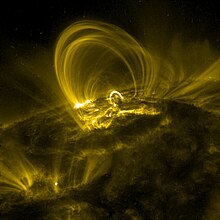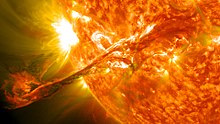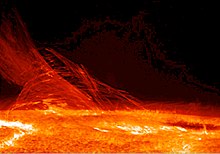From Wikipedia, the free encyclopedia

NASA Astronaut Bruce McCandless II using a Manned Maneuvering Unit outside Space Shuttle Challenger on shuttle mission STS-41-B in 1984.
An astronaut (or cosmonaut) is a person trained by a human spaceflight program to command, pilot, or serve as a crew member of a spacecraft. Although generally reserved for professional space travelers, the terms are sometimes applied to anyone who travels into space, including scientists, politicians, journalists, and tourists.[1][2]
Starting in the 1950s up to 2002, astronauts were sponsored and trained exclusively by governments, either by the military or by civilian space agencies. With the suborbital flight of the privately funded SpaceShipOne in 2004, a new category of astronaut was created: the commercial astronaut.
Definition
The criteria for what constitutes human spaceflight vary. The Fédération Aéronautique Internationale (FAI) Sporting Code for astronautics recognizes only flights that exceed an altitude of 100 kilometers (62 mi).[3] In the United States, professional, military, and commercial astronauts who travel above an altitude of 50 miles (80 km)[4] are awarded astronaut wings.
As of 8 June 2013[update], a total of 532 people from 36 countries have reached 100 km (62 mi) or more in altitude, of which 529 reached low Earth orbit or beyond.[5][6] Of these, 24 people have traveled beyond Low Earth orbit, to either lunar or trans-lunar orbit or to the surface of the moon; three of the 24 did so twice: Jim Lovell, John Young and Eugene Cernan.[7] The three astronauts who have not reached low Earth orbit are spaceplane pilots Joe Walker, Mike Melvill, and Brian Binnie.
As of 20 June 2011[update], under the U.S. definition 538 people qualify as having reached space, above 50 miles (80 km) altitude. Of eight X-15 pilots who exceeded 50 miles (80 km) in altitude, only one exceeded 100 kilometers (about 62 miles).[8] Space travelers have spent over 41,790 man-days (114.5 man-years) in space, including over 100 astronaut-days of spacewalks.[8][9] As of 2008, the man with the longest cumulative time in space is Sergei K. Krikalev, who has spent 803 days, 9 hours and 39 minutes, or 2.2 years, in space.[10][11] Peggy A. Whitson holds the record for the most time in space by a woman, 377 days.[12]
Terminology
English
In English-speaking nations, a professional space traveler is called an astronaut.[13] The term derives from the Greek words ástron (ἄστρον), meaning "star", and nautes (ναύτης), meaning "sailor". The first known use of the term "astronaut" in the modern sense was by Neil R. Jones in his short story "The Death's Head Meteor" in 1930. The word itself had been known earlier. For example, in Percy Greg's 1880 book Across the Zodiac, "astronaut" referred to a spacecraft. In Les Navigateurs de l'Infini (1925) of J.-H. Rosny aîné, the word astronautique (astronautic) was used. The word may have been inspired by "aeronaut", an older term for an air traveler first applied (in 1784) to balloonists. An early use in a non-fiction publication is Eric Frank Russell's poem "The Astronaut" in the November 1934 Bulletin of the British Interplanetary Society.[14]The first known formal use of the term astronautics in the scientific community was the establishment of the annual International Astronautical Congress in 1950 and the subsequent founding of the International Astronautical Federation the following year.[15]
NASA applies the term astronaut to any crew member aboard NASA spacecraft bound for Earth orbit or beyond. NASA also uses the term as a title for those selected to join its Astronaut Corps.[16] The European Space Agency similarly uses the term astronaut for members of its Astronaut Corps.[17]
Russian
By convention, an astronaut employed by the Russian Federal Space Agency (or its Soviet predecessor) is called a cosmonaut in English texts.[16] The word is an anglicisation of the Russian word kosmonavt (Russian: космонавт Russian pronunciation: [kəsmɐˈnaft]), one who works in space outside the Earth's atmosphere, a space traveler,[18] which derives from the Greek words kosmos (κόσμος), meaning "universe", and nautes (ναύτης), meaning "sailor". Other countries of the former Eastern Bloc use variations of the Russian word kosmonavt, such as the Polish kosmonauta.The Soviet Air Force pilot Yuri Gagarin was the first cosmonaut—indeed the first person—in space. Valentina Tereshkova, a Russian factory worker, was the first woman in space, as well as arguably the second civilian to make it there (see below for a further discussion of civilians in space). On March 14, 1995, Norman Thagard became the first American to ride to space on board a Russian launch vehicle, and thus became the first "American cosmonaut".[citation needed]Chinese
Official English-language texts issued by the government of China use astronaut while texts in Russian use космонавт (cosmonaut).[19][20] In official Chinese-language texts, "yǔ háng yuán" (宇航员, "space navigating personnel") is used for astronauts and cosmonauts, and "háng tiān yuán" (航天员, "space navigating personnel") is used for Chinese astronauts. The phrase "tài kōng rén" (太空人, "spaceman") is often used in Hong Kong and Taiwan.[citation needed]The term taikonaut is used by some English-language news media organizations for professional space travelers from China.[21] The word has featured in the Longman and Oxford English dictionaries, the latter of which describes it as "a hybrid of the Chinese term taikong (space) and the Greek naut (sailor)"; the term became more common in 2003 when China sent its first astronaut Yang Liwei into space aboard the Shenzhou 5 spacecraft.[22] This is the term used by Xinhua News Agency in the English version of the Chinese People's Daily since the advent of the Chinese space program.[23] The origin of the term is unclear; as early as May 1998, Chiew Lee Yih (趙裡昱) from Malaysia, used it in newsgroups.[24][25]
Other terms
With the rise of space tourism, NASA and the Russian Federal Space Agency agreed to use the term "spaceflight participant" to distinguish those space travelers from professional astronauts on missions coordinated by those two agencies.[citation needed]While no nation other than the Russian Federation (and previously the former Soviet Union), the United States, and China have launched a manned spacecraft, several other nations have sent people into space in cooperation with one of these countries. Inspired partly by these missions, other synonyms for astronaut have entered occasional English usage. For example, the term spationaut (French spelling: spationaute) is sometimes used to describe French space travelers, from the Latin word spatium for "space", the Malay term angkasawan was used to describe participants in the Angkasawan program, and the Indian Space Research Organization hope to launch a spacecraft in 2018 that would carry vyomanauts, coined from the Sanskrit word for space.[citation needed]
Space travel milestones
Alan Shepard became the first American and second person in space on May 5, 1961 on a 15-minute sub-orbital flight. The first American woman in space was Sally Ride, during Space Shuttle Challenger's mission STS-7, on June 18, 1983.[26] In 1992 Mae Jemison became the first African American woman to travel in space aboard STS-47.
Cosmonaut Alexei Leonov was the first person to conduct an extravehicular activity (EVA), (commonly called a "spacewalk"), on March 18, 1965, on the Soviet Union's Voskhod 2 mission. This was followed two and a half months later by astronaut Ed White who made the first American EVA on NASA's Gemini 4 mission.[27]
The first manned mission to orbit the Moon, Apollo 8, included American William Anders who was born in Hong Kong, making him the first Asian-born astronaut in 1968.
The Soviet Union, through its Intercosmos program, allowed people from other "socialist" (i.e. Warsaw Pact and other Soviet-allied) countries to fly on its missions, with the notable exception of France participating in Soyuz TM-7. An example is Czechoslovak Vladimír Remek, the first cosmonaut from a country other than the Soviet Union or the United States, who flew to space in 1978 on a Soyuz-U rocket.[28]
On July 23, 1980, Pham Tuan of Vietnam became the first Asian in space when he flew aboard Soyuz 37.[29] Also in 1980, Cuban Arnaldo Tamayo Méndez became the first person of Hispanic and black African descent to fly in space, and in 1983, Guion Bluford became the first African American to fly into space. In April 1985, Taylor Wang became the first ethnic Chinese person in space.[30][31] The first person born in Africa to fly in space was Patrick Baudry (France), in 1985.[32][33] In 1985, Saudi Arabian Prince Sultan Bin Salman Bin AbdulAziz Al-Saud became the first Arab Muslim astronaut in space.[34] In 1988, Abdul Ahad Mohmand became the first Afghan to reach space, spending nine days aboard the Mir space station.[35]
With the larger number of seats available on the Space Shuttle, the U.S. began taking international astronauts. In 1983, Ulf Merbold of West Germany became the first non-US citizen to fly in a US spacecraft. In 1984, Marc Garneau became the first of 8 Canadian astronauts to fly in space (through 2010).[36] In 1985, Rodolfo Neri Vela became the first Mexican-born person in space.[37] In 1991, Helen Sharman became the first Briton to fly in space.[38] In 2002, Mark Shuttleworth became the first citizen of an African country to fly in space, as a paying spaceflight participant.[39] In 2003, Ilan Ramon became the first Israeli to fly in space, although he died during a re-entry accident.
On October 15, 2003, Yang Liwei became China's first astronaut on the Shenzhou 5 spacecraft.
Age milestones
The youngest person to fly in space is Gherman Titov, who was 25 years old when he flew Vostok 2. (Titov was also the first person to suffer space sickness).[40][41] The oldest person who has flown in space is John Glenn, who was 77 when he flew on STS-95.[42]Duration and distance milestones
The longest stay in space thus far has been 438 days, by Russian Valeri Polyakov.[8] As of 2006, the most spaceflights by an individual astronaut is seven, a record held by both Jerry L. Ross and Franklin Chang-Diaz. The farthest distance from Earth an astronaut has traveled was 401,056 km (249,205 mi), when Jim Lovell, Jack Swigert, and Fred Haise went around the Moon during the Apollo 13 emergency.[8]Civilian and non-government milestones
Depending on the exact definition of 'civilian', the first civilian in space was either Valentina Tereshkova[43] aboard Vostok 6 (she also became the first woman in space on that mission) or Joseph Albert Walker[44][45] on X-15 Flight 90 a month later. Tereshkova was only honorarily inducted into the USSR's Air Force, which had no female pilots whatsoever at that time. Joe Walker had joined the US Army Air Force but was not a member during his flight. The first people in space who had never been a member of any country's armed forces were both Konstantin Feoktistov and Boris Yegorov aboard Voskhod 1.The first non-governmental space traveler was Byron K. Lichtenberg, a researcher from the Massachusetts Institute of Technology who flew on STS-9 in 1983.[46] In December 1990, Toyohiro Akiyama became the first paying space traveler as a reporter for Tokyo Broadcasting System, a visit to Mir as part of an estimated $12 million (USD) deal with a Japanese TV station, although at the time, the term used to refer to Akiyama was "Research Cosmonaut".[47][48][49] Akiyama suffered severe space sickness during his mission, which affected his productivity.[48]
The first self-funded space tourist was Dennis Tito on board the Russian spacecraft Soyuz TM-3 on April 28, 2001.
Self-funded travelers
The first person to fly on an entirely privately funded mission was Mike Melvill, piloting SpaceShipOne flight 15P on a suborbital journey, although he was a test pilot employed by Scaled Composites and not an actual paying space tourist.[50][51] Seven others have paid to Russian Space Agency to fly into space:- Dennis Tito (American): April 28 – May 6, 2001 (ISS)
- Mark Shuttleworth (South African): April 25 – May 5, 2002 (ISS)
- Gregory Olsen (American): October 1–11, 2005 (ISS)
- Anousheh Ansari (Iranian / American): September 18–29, 2006 (ISS)
- Charles Simonyi (Hungarian / American): April 7–21, 2007 (ISS), March 26 – April 8, 2009 (ISS)
- Richard Garriott (British / American): October 12–24, 2008 (ISS)
- Guy Laliberté (Canadian): September 30, 2009 – October 11, 2009 (ISS)
Training
Once selected, NASA astronauts go through twenty months of training in a variety of areas, including training for extravehicular activity in a facility such as NASA's Neutral Buoyancy Laboratory.[1][53] Astronauts-in-training may also experience short periods of weightlessness in aircraft called the "vomit comet", the nickname given to a pair of modified KC-135s (retired in 2000 and 2004 respectively, and replaced in 2005 with a C-9) which perform parabolic flights.[52] Astronauts are also required to accumulate a number of flight hours in high-performance jet aircraft. This is mostly done in T-38 jet aircraft out of Ellington Field, due to its proximity to the Johnson Space Center. Ellington Field is also where the Shuttle Training Aircraft is maintained and developed, although most flights of the aircraft are done out of Edwards Air Force Base.
NASA candidacy requirements
- Be citizens of the United States.[52][55]
- Pass a strict physical examination, and have a near and distant visual acuity correctable to 20/20 (6/6). Blood pressure, while sitting, must be no greater than 140 over 90.
Commander and Pilot
- A bachelor's degree in engineering, biological science, physical science or mathematics is required.
- At least 1,000 hours' flying time as pilot-in-command in jet aircraft. Experience as a test pilot is desirable.
- Height must be 5 ft 2 in to 6 ft 2 in (1.58 to 1.88 m).
- Distant visual acuity must be correctable to 20/20 in each eye.
- The refractive surgical procedures of the eye, PRK (Photorefractive keratectomy) and LASIK, are now allowed, providing at least 1 year has passed since the date of the procedure with no permanent adverse after effects. For those applicants under final consideration, an operative report on the surgical procedure will be requested.
Mission Specialist
- A bachelor's degree in engineering, biological science, physical science or mathematics, as well as at least three years of related professional experience (graduate work or studies) and an advanced degree, such as a master's degree (one to three years) or a doctoral degree (three years or more).
- Applicant's height must be between 4 ft. 10.5 in. and 6 ft. 4 in.
Mission Specialist Educator
- Applicants must have a bachelor's degree with teaching experience, including work at the kindergarten through twelfth grade level. An advanced degree, such as a master's degree or a doctoral degree, is not required, but is strongly desired.[56]
Health risks of space travel
Astronauts are susceptible to a variety of health risks including decompression sickness, barotrauma, immunodeficiencies, loss of bone and muscle, loss of eyesight, orthostatic intolerance, sleep disturbances, and radiation injury.[62][63][64][65][66][67][68][69][70] A variety of large scale medical studies are being conducted in space via the National Space and Biomedical Research Institute (NSBRI) to address these issues. Prominent among these is the Advanced Diagnostic Ultrasound in Microgravity Study in which astronauts (including former ISS commanders Leroy Chiao and Gennady Padalka) perform ultrasound scans under the guidance of remote experts to diagnose and potentially treat hundreds of medical conditions in space. This study's techniques are now being applied to cover professional and Olympic sports injuries as well as ultrasound performed by non-expert operators in medical and high school students. It is anticipated that remote guided ultrasound will have application on Earth in emergency and rural care situations, where access to a trained physician is often rare.[71][72][73]On December 31, 2012, a NASA-supported study reported that manned spaceflight may harm the brain and accelerate the onset of Alzheimer's disease.[74][75][76]
Food and drink
An astronaut on the International Space Station requires about 0.83 kilograms (1.83 pounds) weight of food inclusive of food packaging per meal each day. (The packaging for each meal weighs around 0.12 kilograms - 0.27 pounds) Longer-duration missions require more food.Shuttle astronauts worked with nutritionists to select menus that appeal to their individual tastes. Five months before flight, menus are selected and analyzed for nutritional content by the shuttle dietician. Foods are tested to see how they will react in a reduced gravity environment. Caloric requirements are determined using a basal energy expenditure (BEE) formula. On Earth, the average American uses about 35 gallons (132 liters) of water every day. On board the ISS astronauts limit water use to only about three gallons (11 liters) per day.[77]
Insignia
In Russia, cosmonauts are awarded Pilot-Cosmonaut of the Russian Federation upon completion of their missions, often accompanied with the award of Hero of the Russian Federation. This follows the practice established in the USSR where cosmonauts were usually awarded the title Hero of the Soviet Union.At NASA, those who complete astronaut candidate training receive a silver lapel pin. Once they have flown in space, they receive a gold pin. U.S. astronauts who also have active-duty military status receive a special qualification badge, known as the Astronaut Badge, after participation on a spaceflight. The United States Air Force also presents an Astronaut Badge to its pilots who exceed 50 miles (80 km) in altitude.
Deaths
Eighteen astronauts (fourteen men and four women) have lost their lives during four space flights. By nationality, thirteen were American (including one of Indian origin), four were Russian (Soviet Union), and one was Israeli.Eleven people (all men) have lost their lives training for spaceflight: eight Americans and three Russians. Six of these were in crashes of training jet aircraft, one drowned during water recovery training, and four were due to fires in pure oxygen environments.The Space Mirror Memorial, which stands on the grounds of the John F. Kennedy Space Center Visitor Complex, commemorates the lives of the men and women who have died during spaceflight and during training in the space programs of the United States. In addition to twenty NASA career astronauts, the memorial includes the names of a U.S. Air Force X-15 test pilot, a U.S. Air Force officer who died while training for a then-classified military space program, and a civilian spaceflight participant.













 can be calculated by the
can be calculated by the  , where
, where  is the
is the  the
the  the plasma temperature. It is evident from the equation that the plasma pressure lowers when the plasma temperature decreases respect to the surrounding regions or when the zone of intense magnetic field empties. The same physical effect makes
the plasma temperature. It is evident from the equation that the plasma pressure lowers when the plasma temperature decreases respect to the surrounding regions or when the zone of intense magnetic field empties. The same physical effect makes 





 is the
is the  the electron mass,
the electron mass,  the electric charge of the electron,
the electric charge of the electron,

 is roughly 20 in the corona, with a mean temperature of 1 MK and a density of 1015 particles/m3, and about 10 in the chromosphere, where the temperature is approximately 10kK and the particle density is of the order of 1018 particles/m3, and in practice it can be assumed constant.
is roughly 20 in the corona, with a mean temperature of 1 MK and a density of 1015 particles/m3, and about 10 in the chromosphere, where the temperature is approximately 10kK and the particle density is of the order of 1018 particles/m3, and in practice it can be assumed constant. the heat for a volume unit, expressed in J m−3, the Fourier equation of heat transfer, to be computed only along the direction
the heat for a volume unit, expressed in J m−3, the Fourier equation of heat transfer, to be computed only along the direction  of the field line, becomes
of the field line, becomes .
.

